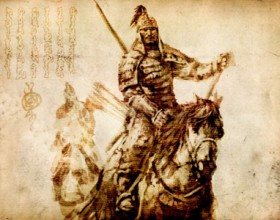Part IV – The Silk Road – Cosmopolitan and Confucian Revival: Tang Dynasty 618 – 907 CE & Song Dynasty 960 – 1279 CE
- Introduction
- Tang Dynasty 618-907 – Reform
- The Tang Dynasty – Innovation
- The Tang Dynasty – The Silk Road
- Tang Poetry and Art
- Northern Song Dynasty 960-1127 – Northern Rebellion, Regionalism and Reunification
- Period of the Five Dynasties and Ten Kingdoms
- China Reunified – Founding of the Song Dynasty
- Weaknesses of the Song Imperial Governments
- Song’s Flourishing Economy
- The Southern Song Dynasty 1127-1279 – Cultural Conservatism and Foot Binding
- Expanding Southern Song Economy
- Southern Song Art
- The Past in the Present – Historical Themes in Today’s China
- What Happened Next?
Introduction
As the Tang Dynasty strengthened after the fall of the Sui Dynasty in 618 CE, it confronted what was becoming a familiar set of challenges for all Chinese emperors wishing to consolidate control over a unified China. These challenges included managing the power struggles of court where eunuchs, concubines, official-scholars, and royal family members all jockeyed for power and control. In addition, they had to keep tax coffers filled through high agricultural productivity and maintain a strong military in order to defend northern borders while preventing that same military from challenging imperial authority. Added to all of this was the threat of regional power growth, the execution of large public works for the benefit of the entire Chinese society, and the maintenance of moral cultural authority in order to earn the loyalty of its subjects. As ever, it was a tall order.
The underpinning of this moral cultural authority was increasingly challenged during the Tang and Song Dynasties as the Chinese encountered greater cultural diversity than they had in previous eras. Specifically, the Tang court was one of the most cosmopolitan courts in all of China’s history. During the Tang Dynasty, the Silk Road flourished and sea trade with Southeast Asia developed as more and more Chinese migrated south. The influence of Buddhism continued to grow, causing in turn a revival of Daoist thought and study. In 1127 CE, the Song Dynasty in the north was ultimately overrun by nomadic tribes, causing the Chinese courts to flee south. Yet, despite all of these international influences, China continually returned to the values of its ancient Confucian culture as the best way to create a homogeneous, unified, prosperous and stable society.
Tang Dynasty 618-907 – Reform
Expensive and failed military campaigns against the northern part of what is now Korea led to excessive tax increases which eventually caused revolt against the Sui Dynasty. Li Yuan, a major military Sui commander, eventually turned against the Sui and conquering the country for himself. He founded the Tang Dynasty in 618. It took until 624 for all of China to come under his rule. Once reunification had been achieved, Li Yuan demobilized his armies, preventing the rise of powerful regional generals that, much as he had done, might lay claim to the throne. Powerful southern families were forced to move north and the Sui’s “rule of avoidance” was implemented, so that no official could serve in his home district. The first Tang emperor continued the equal field system, ensuring that land was allocated equally to adult male taxpayers based on an annual census.
One of Li Yuan’s more controversial policies was his attempt to limit the power of the Buddhist and Daoist centers which were formerly beyond the reach of imperial tax collection. Exemption from taxation enabled the monasteries to establish huge landholdings and large numbers of tenant farmers. From Li Yuan’s point of view, these great religious estates transcended political boundaries, threatened the new regime, and represented a potentially significant tax base which could be used to restore depleted imperial coffers. By mid-626, the Emperor ordered that only one Daoist and three Buddhist monasteries were permitted in the capital and only one of each faith in each prefecture. This was a spectacular restriction given that it was estimated that within the capital and surrounding areas alone were over 120 Buddhist and 12 Taoist monasteries. Yet the order was never fully enacted. Li Yuan was deposed by his second son, Tang Taizong, who reversed his father’s order.
Building on the civil and military achievements of his father, Tang Taizong embarked on a program of civil reform tempered by Confucian principles. He also launched military campaigns which succeeded in expanding the territorial boundaries of the empire. At the heart of the civil reform was the expansion of the Sui’s legal reform. The result was the creation of a far-reaching legal code, the oldest surviving code in China today. The Tang code persisted as the foundation of Chinese legal practice until the 14th century. It also served as model legal codes for Japan, Korea and Vietnam.
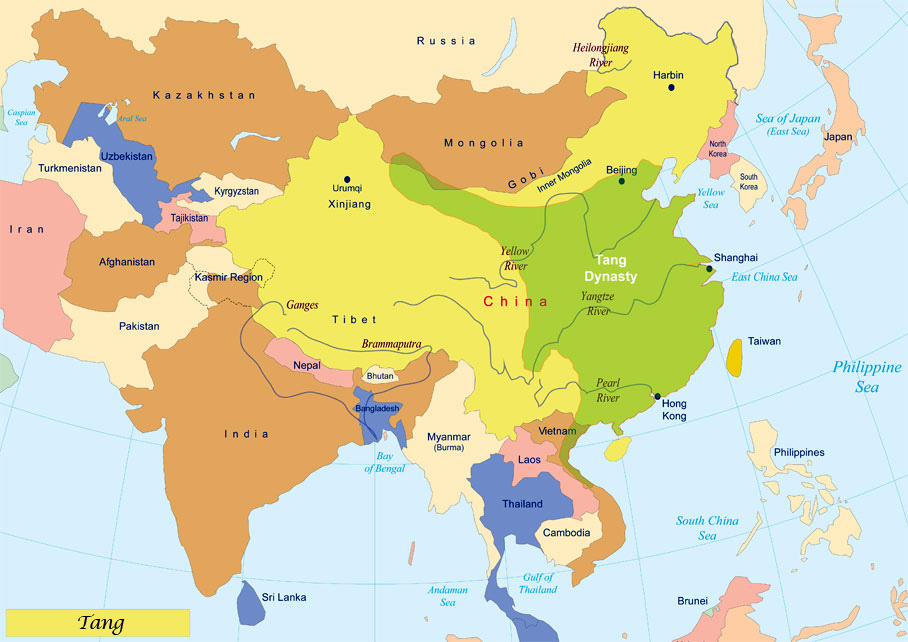
The Tang Dynasty – Innovation
The Tang Dynasty was also highly innovative, especially in the fields of gunpowder, mechanical clocks and the use of water power. Tang scholars devoted much time to systematizing knowledge and historical texts. The civil service examinations were reinstated. Book printing was developed; the world’s oldest existing printed book is a copy of the Buddhist text the Diamond Sutra dated 868. The scroll format for long text began to be superseded by flat books with folded pages, a format much more convenient for storage. The invention of printed books revolutionized the imperial communication of ideas and continued to facilitate the creation of a homogeneous Chinese culture, as printed books enabled Chinese norms and expectations to be even more widely dispersed throughout the population.The Tang Dynasty – The Silk Road
The Silk Road thrived under the Tang Dynasty. As the camels and caravans traversed west and east, traders brought many foreign ideas and goods into China. This international exposure made the Tang court one of the most cosmopolitan in China’s history. Buddhism also flourished under the Tang. The Dynasty generously supported Buddhist monasteries and commissioned further Buddhist sculptures. The renowned Buddhist monk, Xuanzang, made a 17-year trip to India to bring back to China Buddhist scriptures and teaching. His work provided the Chinese with a deeper understanding of the religion and the differences of the different Buddhists schools. His journey was later recounted in the famous Chinese fiction work Journey to the West.
Due in part to the Tang’s nomadic influences, women were given a relatively high status during the Tang Dynasty. One of China’s most powerful women, Empress Wu, ascended the dynastic throne in 690 as emperor, the only female in China to formally take the title Emperor. She ruled until 705.
Tang Poetry and Art
Poetry became increasingly important in the Tang era. It was viewed as the most authentic and revealing way to articulate feelings and thoughts. Poems were recited at banquets, used to court women, recorded people’s daily activities, and described historic events or scenes of natural beauty. The Complete Poems of the Tang Dynasty contains over 48,000 poems written by 2200 Tang poets. Three Hundred Tang Poems contains samples from all the great Tang poets, including two of China’s greatest poets Li Bo and Du Fu. In fact, many Chinese consider the Tang to be the height of their civilization, particularly culturally. Tang-era costume dramas are frequently shown on Chinese TV. China towns in the West are often referred to by Chinese people as Tangren Jie meaning “Tang people’s street”.
What life was like for the subjects of the Tang who lived far from the imperial capital has been revealed, in part, by a large number of documents found in a cave temple at Dunhuang, in the northwest of China where the Silk Road starts to cross the desert. These documents showed that Tang imperial policies, such as the equal field system, were established even in the far reaches of its empire. The documents also revealed that the state exerted at least some control over local markets, as fragments of official price lists showed that authorities established prices for three qualities of a wide range of goods traded in government-supervised markets, including foodstuffs and textiles. Primary books found with the documents showed that Confucian social ethics primers were used even in schools run by Buddhist monasteries.
Northern Song Dynasty 960-1127 – Northern Rebellion, Regionalism and Reunification
After 760, weather throughout the China was turning colder and drier, ending the temperate period that brought helped contribute to the affluence to the early Tang Dynasty. For the next almost 100 years, harvests declined as did the flow into rivers from glaciers. These drier conditions also affected the steppe grasslands causing unrest along the border. Changing weather conditions along with other factors meant that, by 763, the Tang Court started losing control over its empire. Despite imperial safeguards, in 755 a Chinese general, An Lushan, was able to amass 160,000 troops along China’s northern frontier, and then march on the capital. The Tang government never fully recovered from this rebellion and, after eight years of fighting, was forced to negotiate for peace. The government abandoned the equal field system, instead giving each region tax quotas, allowing them to raise these quotas with great leeway. Government withdrawal from control of land ownership facilitated the growth of large, commanding states. Eventually, these states became so powerful that the country again fragmented. Yet the Tang’s retreat from regional markets, as they lost control over the country, had the unintended consequence of stimulating economic trade. A new economic network of markets and towns began to emerge alongside the official state hierarchy of administrative centers.Period of the Five Dynasties and Ten Kingdoms
The fifty years between the Tang and Song dynasties is called the ‘Period of the Five Dynasties and Ten Kingdoms’ because of the five fleeting regimes in the North and the 10 minor kingdoms competing for power in the South. Interestingly, the period of the Five Dynasties and Ten Kingdoms was marked by renewed militarism. Indeed, in order to gain advantage and build large, loyal armies, some generals shared his family name with his soldiers. This practice allowed military generals to build up an elite army of adopted sons whose kinship was not given by birth, but was earned through sharing the hardship in achieving a common goal.
China Reunified – Founding of the Song Dynasty
China was finally reunified in 960 CE under General Zhao Kuangyin who founded the Song Dynasty under the title Song Taizu. One of Song Taizu’s first steps as leader was to demilitarize China and to recreate a central bureaucratic state organized along strict Confucian ideals where classical scholarship was more highly valued then military expertise. Many new Confucian thinkers, such as the Du You (732-812) and Han Yu (768-824) revitalized Confucian thought. Du You wrote a 5000 page, 200 chapter history of Chinese institutions, Tongdian. Du You argued that corrupt rulers, heavy taxes and frequent labor service drove the people to seek the protection of local strongmen and approved of Sui efforts to make tax burdens equitable and reasonable. Han Yu saw China’s problems in much more cultural terms and argued that a rejuvenation of Confucian learning would bolster the state, by revitalizing values consistent with its subjects’ obedience to the Emperor, and by reminding the ruling classes of their obligation to their citizens. Han Yu felt Buddhism was a barbarian cult and should be eradicated, as it encouraged Chinese citizens to divert from their duty to the Emperor in order to pursue Buddhist observance. Nevertheless, this renewed emphasis on classical scholarship eventually created vulnerability on the northern borders, as book learning was once again emphasized over military skills. Passing civil service examinations was difficult and required years of intense study and preparation, leaving little time for the practice of military arts. The invention of printing during the Tang Dynasty, and its profusion during the Song Dynasty, made books available to more families, increasing the competition for government appointments, but also creating a vulnerability to invasion through the prioritizing of academic abilities over military power.One of Taizu’s biggest achievements was to disband the regional armies that had plagued the Tang. After Taizu had consolidated control, he encouraged commanders to retire on generous pensions and gradually replaced provincial military governors with civil officials. To avert the rise of new regional strongmen, the Emperor eventually put the whole army under civilian control and ensured that his officers were regularly rotated. Despite this military reorganization and because the Song deemphasize the importance of the military, the Song was constantly challenged by northern nomads. By 1004, a northern nomadic tribe, the Khitans, managed to occupy much of the Yellow River Valley, forcing the Song to sign a peace treaty with the nomads as equals. In exchange for retreating from the lands surrounding the Yellow River Valley, the nomads extorted huge annual payments from the Chinese in silk and silver, which placed enormous pressure on imperial resources.
The creation of the Song Dynasty was accompanied by more favorable climatic conditions. From 960 to 1250, China enjoyed a stronger and wetter monsoon which meant in turn greater agricultural productivity. However, while China was enjoying a return to normal rain levels, tree ring data indicates that the North Mongolian steppes lands underwent significant periods of reduced rainfall extending between 900-1064, 1115-39, and 1180-90. These periods of diminished rainfall resulted in an increase in nomadic incursions into China.
Weaknesses of the Song Imperial Governments
Despite its efforts at military reform, and its ample supply of worthy emperors and statesmen, the Song Dynasty faced two main weaknesses. The arrival of printing allowed bureaucratic regulation to multiply, so that governing and reforming the government became increasingly cumbersome. For example, rules about the use of one imperial ritual hall filled 1200 volumes. Court struggles also hindered effective rule. Disputes among officials seeking to influence the Emperor often escalated; each party lined up allies, and focused their energies on devising ways to oust their opponents. Eunuchs, concubines, and members of the emperor’s extended family constantly vied for power and advantage, often at the expense of what was best for the country.
Song’s Flourishing Economy
Despite these challenges, the Northern Song economy flourished. In 742 China’s population was approximately 50 million; by 1100, it had reached almost 100 million people. Its food supply steadily increased and denser settlement patterns aided commercialization. The need to transport the growing quantity and range of Chinese products fueled inland waterways and coastal shipping industries, providing employment for shipbuilders and sailors. As trade increased, so did the demand for money. By 997, the Song government was minting 800 million coins a year, two and a half times the largest output during the Tang. This need for currency eventually led to the development of paper money, which originated as trading receipts from deposit shops where traders had safeguarded money or goods. By the 1120s, the Song government took control of the deposit shop system, issuing the world’s first government-backed paper money. On the whole, the Song proved capable of managing the new paper currency, avoiding over-printing which would have resulted in high inflation.
The Southern Song Dynasty 1127-1279 – Cultural Conservatism and Foot Binding
By 1127, the northern nomadic Jurchen established a coalition of tribes under the leader Aguda and conquered northern China. The Song imperial court was forced to flee south. The Southern court – known as the Southern Song Dynasty – in reaction to the northern nomadic invasion became less open to foreign ideas and was more sensitive to issues of Chinese cultural identity. Under the Southern Song Dynasty, women were returned to a more subordinate role compared to the freedoms that they enjoyed as a result of the nomadic influences of the Tang court. In particular, foot binding became popular. This excruciating procedure involved tightly binding the feet of very young girls to prevent them from growing normally. The resulting 3 ½ to 4 inch long feet were considered to augment a woman’s beauty and make her movements more feminine and dainty. As for binding grew in popularity and became the new norm, parents were eager to make their daughters more attractive in order to guarantee good marriages and social status. They thus subjected their daughters to years of debilitating pain and impaired mobility. Female literacy also rose during the Southern Song Dynasty as daughters were educated in order to better to educate their sons.Expanding Southern Song Economy
The Southern Song Dynasty enjoyed significant agricultural productivity. This was partly due to increased acreage under cultivation and partly due to new strains of rice that allowed for two and sometimes three crops to be harvested per year. Additionally, cash crops such as tea and sugar expanded both interregional and international trade. The Song also ran the largest iron smelting industry in the world, its output being used for the manufacture of items such as weapons, coins, farm implements and nails. Traditional Southern Song industries such as silk, lacquer and ceramics reached high levels of technical sophistication. Growth in agriculture, cash crops, trade and industrial output led to the growth of cities and market towns.The invention of the printing press also helped fuel economic growth and served to tie the distant regions of China more closely together, China’s northern occupation notwithstanding. Printing also contributed to the spread and standardization of ideas and practices. Handbooks on agriculture, childbirth, pharmacy, divination and Daoist rituals all became more widely available.
The Song’s invention of the compass helped the expansion of long-distance trade between China, Southeast Asia and the Indian Ocean. The compass is considered one of China’s four greatest inventions and was symbolically acknowledged during the opening ceremony of the Beijing Olympics along with paper, the printing press and gunpowder. Sea trade from China’s southeast coast to India introduced many spices into the Chinese diet, including pepper, cloves and saffron, and generated additional economic growth.
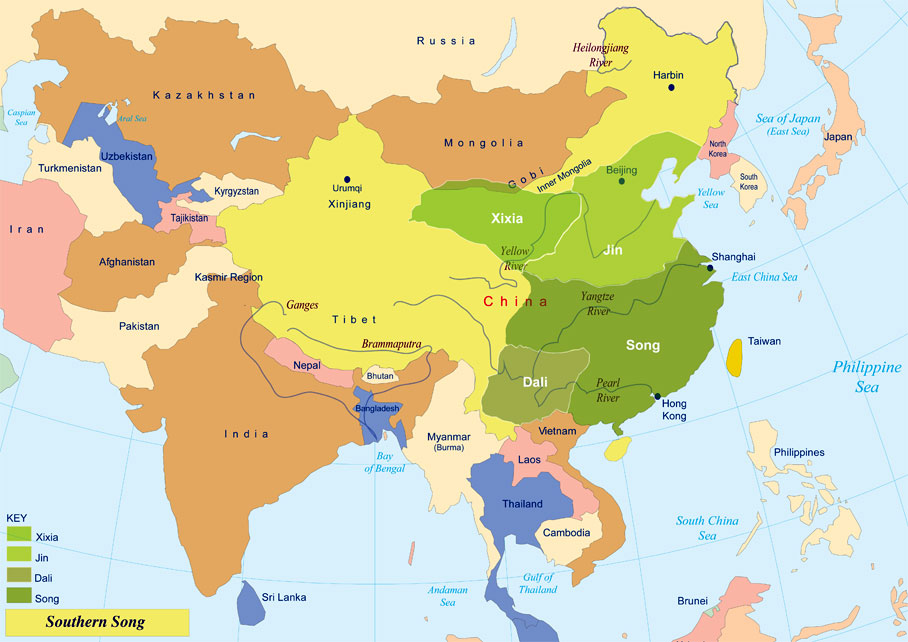
Southern Song Art
Landscape painting reached its height under the Southern Song Dynasty. Executed with ink and brushes and often accented with colored washes, these paintings illustrated the beauty, harmony and magnificence of the natural world, highlighting forests and mountains amid streams and valleys. Human beings were absent or were barely visible from these landscape paintings in order to emphasize how humans were but a small part of the larger harmony of nature. Often these paintings were inscribed with exquisite language and calligraphy which became a key part of the painting itself. Mountains, long seen as sacred places by the Chinese, were key landscape subjects.The Past in the Present – Historical Themes in Today’s China
The Tang Dynasty remains a source of pride among Chinese today, viewed as the high point in Chinese civilizational development and responsible for the invention of one of China’s four great inventions, block printing. Some of the most popular television series in China today are set in the Tang Dynasty era and Journey to the West is one of the most enduring stories in China’s history, with myriad adaptations on stage and screen.
Just as it was difficult for the elite of the Tang and Song dynasties, today maintaining control over China’s provinces as the Chinese economy expands remains a key challenge for Chinese leaders. As China has transformed from a communist to a largely-capitalist economy, it has ceded much control to its regional centers. This growth in regional provincial power has manifested in many ways, the most important of which may be the challenges Beijing has encountered when trying to force national legislation at the local level. An improving but still insufficient legal system and lack of press freedoms has meant that it has sometimes been tricky for Beijing to exert its authority, especially over more wealthy areas. Growing inequality as a result of its rapid economic expansion has also caused regional dissatisfaction, as poor regions see already-wealthier regions get even richer, while they struggle to feed, employ, and educate their populations.
The appropriate role of women in Chinese society has continued to be debated through modern times. As the West began to demonstrate its technological, military and economic dominance from the mid-1800s onwards, China looked at the role of women in society as symbolic of its larger problems. Indeed, the statement that “Women hold up half the sky” was proclaimed by Mao Zedong to communicate that women were a resource that should be deployed outside the homes and into the agricultural, industrial and professional fields instead of being closeted away as they were from the Song Dynasty onwards.What Happened Next?
After being driven south by the northern frontier nomadic peoples, the Song were eventually defeated by a Mongol army led by Kublai Khan, grandson of the great Genghis Khan. Kublai established the first non-Han Chinese led dynasty, the Yuan. He also expanded Chinese territory to include Tibet and what is now Xinjiang, giving the Yuan Dynasty borders very close to the China we see today. The story continues in The Mongol Empire.




![By Lautam17 (Own work) [CC-BY-SA-3.0 (http://creativecommons.org/licenses/by-sa/3.0)], via Wikimedia Commons](https://chinafolio.com/wp-content/uploads/2010/05/China_Mechanical_Clock-wiki.jpg)

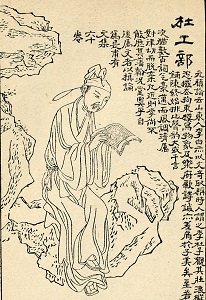
![PericlesofAthens at en.wikipedia [GFDL (http://www.gnu.org/copyleft/fdl.html), CC-BY-SA-3.0 (http://creativecommons.org/licenses/by-sa/3.0/) or CC-BY-SA-2.0 (http://creativecommons.org/licenses/by-sa/2.0)], from Wikimedia Commons](https://chinafolio.com/wp-content/uploads/2010/05/Emperor-fleeing-the-rebellion-of-An-Lushan-755-wiki.jpg)
![By Anonymous [Public domain], via Wikimedia Commons](https://chinafolio.com/wp-content/uploads/2010/05/Song_Taizu-founder-of-the-Song-Dynasty-wiki.jpg)
![By Monaneko (Own work) [GFDL (http://www.gnu.org/copyleft/fdl.html) or CC-BY-SA-3.0-2.5-2.0-1.0 (http://creativecommons.org/licenses/by-sa/3.0)], via Wikimedia Commons](https://chinafolio.com/wp-content/uploads/2010/05/Song-Dynasty-coin-wiki.jpg)
![By William Henry Flower (Fashion in Deformity) [Public domain], via Wikimedia Commons](https://chinafolio.com/wp-content/uploads/2010/05/Chinese_Womans_Foot-wiki.jpg)
![By User:PericlesofAthens [GFDL (http://www.gnu.org/copyleft/fdl.html) or CC-BY-SA-3.0-2.5-2.0-1.0 (http://creativecommons.org/licenses/by-sa/3.0)], via Wikimedia Commons](https://chinafolio.com/wp-content/uploads/2010/05/Red_lacquer_tray_with_gold_engraving_Song_Dynasty-wiki.jpg)
![Dong Yuan [Public domain], via Wikimedia Commons](https://chinafolio.com/wp-content/uploads/2010/05/Song-Dynasty-landscape-painting-Dong-Yuan-River-wiki.jpg)
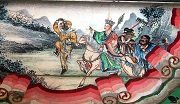
![By James Ricalton [Public domain], via Wikimedia Commons](https://chinafolio.com/wp-content/uploads/2010/05/Foot_binding-_wealthy_Chinese_women-1900-Beijing-wiki.jpg)

